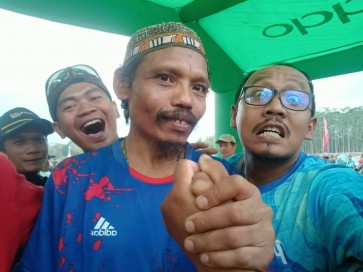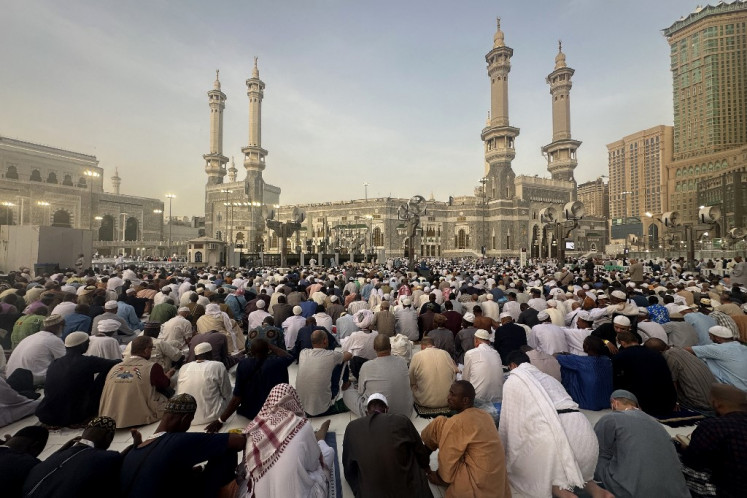Style with a conscience
Up for grabs: Eco-fashion collections are displayed at the Little Tree shop in Bali
Change text size
Gift Premium Articles
to Anyone

Up for grabs: Eco-fashion collections are displayed at the Little Tree shop in Bali.
Green is the new black. Eco-fashion is not just another a trend that will lose its appeal in the next season, it's a movement.
Antwerp designer Martin Margiela may have never imagined that his decision to create a fashion collection from recycled materials in the 1990s could lead to a movement to help save the planet.
But it wasn't until Stella McCartney hit the runway with her eco-fashion collections that the green movement was really placed under the spotlight.
Fast forward from then, and today green fashion has gone from being just about using recycled material to being a sustainable industry that respects the environment, workers and consumers.
'Fashion is one of the most polluted industries on the planet,' says designer Maya Nursari, a newcomer to the industry.
'The process uses many chemicals that can destroy the environment, [cotton] plants use so many pesticides and many workers and farmers could get cancer because of this.'
Green activists often address negative issues in the fashion industry, accusing it of sacrificing the environment just for a piece of clothing.
Keeping this in mind, some Bali designers have joined the movement, with two designers ' Maya and Tianita ' creating eco-friendly apparels under the brands of Nurkamaya and Sarita Bunga Bali.
'People need to understand how the clothes are processed and know where they come from, so they don't feel guilty when wearing them,' said Maya when recently introducing their collections at the Little Tree in Kuta.
In her contribution, Maya chose organic materials for her designs. Using rayon fabrics made from bamboo fiber and organic cotton, she created stunning designs of daily wear suitable for tropical weather.

'Fabrics made from bamboo fiber and organic cotton are very soft, very comfortable to wear,' Maya said. 'It's from farmed bamboo, not from the wild, so it won't cause deforestation. Besides, bamboo trees grow easily.'
Another eco-friendly fabric is rayon, made from the cellulose of beech wood. The fabric is used by Goddess on the Go, a brand found in Ubud.
The designer, Janet Molloy, who started the brand in 2010, chooses her fabric not only because it's very comfortable for activities like yoga and traveling but it is biodegradable and environmentally friendly.
'I fell in love with the fabric's softness and coolness. I wanted all my clothes to feel this good. When I researched it and found nobody was making it in a range of sizes and colors, I decided to do it,' said Molloy, whose signature fabric uses beech trees, which grow on marginal land and regrow naturally.
'Cotton needs very fertile soil, which is better utilized for growing food and it also needs massive amounts of water, which is very scarce in areas suitable for growing cotton,' she says.
Eco-fashion also pays attention to ensuring the production process is safe for the environment, workers and surrounding neighborhoods. One of the most dangerous processes in fashion is dyeing the fabrics.
Sari Bunga Bali designer Tianita said conventional fashion-making often used hazardous chemicals in the coloring process that could pollute the surrounding environment.
'There is no work safety [control] in Indonesia. The poison can be inhaled from the polluted environment. Some clothing factories are located in housing complexes and there is no city planning for this,' she says.
'If the process is done on a small scale it's probably OK, but what if it is done on a larger scale? Bali is a small island, the groundwater can be polluted with metals and it's not safe for drinking.'
Responding to the problem, Tianita uses semi-organic dye imported from Europe and takes forward a sustainable coloring process for her label. 'We manage the wastewater properly. We have waste management and reuse the wastewater many times,' she said.
The ethical fashion trade is also important for some eco-designers. Maya tries to carefully select suppliers and tailors that share her principles and avoids those employing children or not establishing fair trade.
'I know how damaging this is so I have to make sure it's 100 percent green. It took me a year to finally get the right suppliers,' said Maya, who now has two brands ' 100%Love, which uses an environmentally friendly process; and Nurkamaya, which uses organic materials.
Still, there are challenges. One is to fully apply natural colors to the organic fabrics and get same result as in regular fashion.
Tianita said such a process made the color look dull and faded, like old clothes that had been washed too many times.
'It took us a while to finally get the right colors,' she says.
Maya also experienced similar problems. Fabrics made from bamboo fiber tend to look plain and are only available in white and black. But the problem didn't discourage her and forced her to further explore her creative side and create designs with unique and fresh twists.
'Conventional fabrics often come out with print and the designers only think about the designs. With organic fabrics, we have to concept everything,' Maya said.
Molloy said the fashion choice these women made would have a positive impact on the environment ' not just by being a part of the clean manufacturing process, but having clothes that do not need dry cleaning and ironing.
'These clothes are long lasting ' they don't need to be replaced as often. So by making the right choice, the effects can be wide reaching.'









